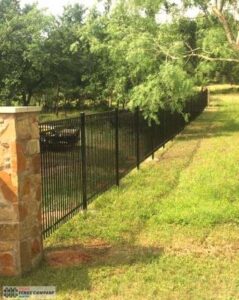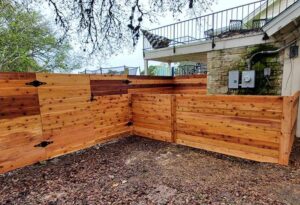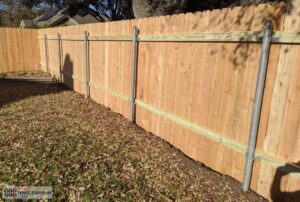Save Money Fence Installation Austin: How To Guide
TL;DR
Saving money on fence installation in Austin is possible with the right strategy. Focus on budget-friendly materials, opting for DIY fence installation where possible, and choosing efficient contractors like Atlas Fence Company. Planning early, considering affordable fence styles, and tackling small repairs instead of full replacements can save you money in the long run. Get a free estimate to start budgeting for your next fence project.
Table of Contents
TogglePlanning Your Fence Project

A well-planned fence project is the foundation for a smooth, cost-effective fence installation. Before you start, take time to consider your property’s needs and the best fencing options for your goals and budget. Whether you’re thinking about a classic wooden fence for privacy, a chain link fence for security, or a wrought iron fence for a touch of elegance, your choice will influence every step of the installation process.
Start by evaluating the main purpose of your new fence. Are you looking to boost curb appeal, keep pets safe, or add privacy from nosy neighbors? For straightforward needs and simple property lines, a DIY fence installation can be a great way to save money. Installing a basic chain link fence or a standard wooden fence is often manageable for handy homeowners, especially if you have the right tools and a little help.
However, if your fence project involves complex fences—like those with multiple corners, changes in elevation, or custom designs—a professional fence installation is usually the smarter investment. Professional fence installers have the experience to handle challenging layouts, ensure your fence is installed correctly, and comply with local building codes. This can help you avoid costly mistakes and ensure your fence stands the test of time.
When planning, also consider the long-term maintenance and durability of your chosen fence type. Wrought iron fences offer a classic look and require less frequent replacement, while chain link fences are budget-friendly and low maintenance. Wooden fences provide natural beauty but may need more upkeep.
To get started, sketch out your property lines, decide on the fence type, and determine if your project is simple enough for a DIY fence or if it’s best left to a professional fence installer. Careful planning at this stage can help you save money, avoid surprises, and ensure your fence installation goes smoothly from start to finish.
Affordable fence material options
One of the most effective ways to reduce fence installation costs is by selecting affordable materials. Fence installation costs are often measured per linear foot, making it easier to compare the cost per linear foot for different fence types and to budget accordingly. There are many fence types available, including wood, vinyl, composite, and metal fences, each with its own cost, durability, and maintenance profile. For example, metal fences such as steel or wrought iron are known for their durability and aesthetic appeal, but they may require periodic maintenance like rust prevention and can have different costs compared to wood or vinyl. Additionally, taller or more complex fences require more materials, which increases overall costs. Other materials, such as steel or wrought iron, may also differ in terms of longevity, cost, and maintenance needs compared to traditional wood or vinyl options. Certain materials are naturally less expensive than others, while still offering durability and privacy. Here are a few options:
1. Chain Link Fencing
Chain link fencing is one of the most economical options available. It’s ideal for perimeter fencing or areas where privacy isn’t a concern. With chain link, you can still secure your property without breaking the bank.
- Benefits: Affordable, durable, low-maintenance, quick to install.
- Budget tip: Consider adding privacy slats if you want more coverage without the added cost of wood or vinyl.
2. Wood Fencing
Wood is a versatile and classic option for fencing, and it’s available at different price points. A basic cedar fence (e.g., side-by-side picket) is relatively inexpensive, while a more decorative design, such as board-on-board, can be more costly.
- Benefits: Offers privacy, good for aesthetic appeal.
- Budget tip: Opt for cedar or pine, which are more affordable than composite or vinyl.
3. Vinyl Fencing
Vinyl fences are more expensive initially, but they’re low-maintenance and last much longer than wood fences. If you plan to stay in your home for a long time, vinyl can be a great investment due to its durability.
- Benefits: Long-lasting, requires minimal upkeep.
- Budget tip: Choose standard white vinyl instead of custom colors or designs to keep costs lower.
4. Composite Fencing
While composite fencing (often made from recycled wood and plastic) offers durability and a great look, it’s generally more expensive upfront. However, its low-maintenance nature can save you money on repairs and staining over time.
- Benefits: Long-term cost savings, no need for staining or painting.
- Budget tip: Opt for standard composite rather than custom designs or premium brands.
Choosing the right material for your fence is one of the easiest ways to save money upfront. Once you’ve decided on the material, consider factors like height, design complexity, and gate needs. For more on this, check out our Complete Guide to Fence Installation in Austin.
Opting for simple designs and fewer gates

While it’s tempting to go all out with custom designs and fancy gates, simple designs can save you substantial money. Here’s how:
- Stick to standard heights – Fences taller than 6 feet often require permits and additional materials, which increase costs.
- Minimize gate installation – Each gate (especially for driveways) can be a significant cost driver. Consider fewer gates or larger gates that can serve multiple functions.
- Simpler designs – Going for a straight-run fence without intricate curves, patterns, or angles will save on labor and materials.
A basic fence installation with minimal features can keep costs manageable while still providing the privacy and security you need.
The DIY route vs. professional help
One of the most debated topics in fence installation is whether to take the DIY route or hire a professional. Here’s a quick breakdown:
DIY Fence Installation
If you have the skills, tools, and time, installing the fence yourself can save you money on labor costs. However, DIY projects can be time-consuming and complex, especially if your fence involves heavy materials or an intricate design. It’s important to weigh the potential savings against your ability to handle the work effectively.
- Savings: You can save on labor costs by doing the work yourself.
- Challenges: Fence installation requires precision and knowledge to ensure it’s secure and code-compliant.
Professional Fence Installation
Hiring a pro like Atlas Fence Company ensures that the job gets done right the first time. We have the expertise, equipment, and crew to handle complex installations with ease. We can also help navigate permit requirements and HOA regulations, which could otherwise delay your project.
- Savings: Avoid costly mistakes, rework, and potential fines for non-compliance.
- Challenges: Professional installation may come with an upfront fee, but this can save you money in the long run by ensuring quality and compliance.
How to minimize fence maintenance costs?
A key to saving on your fence investment is minimizing ongoing maintenance costs. Here are a few tips:
- Opt for low-maintenance materials – Materials like composite, vinyl, and ornamental iron require less care over time.
- Stain and seal regularly – If you go with a wood fence, keep up with staining to protect it from weather damage. Learn more in Why Stain a Cedar Fence.
- Fix minor issues early – Small issues, like a leaning post or broken gate latch, can escalate quickly and become more expensive to repair. Stay on top of fence repairs before they turn into bigger problems.
Working with contractors to save money
Choosing a reputable contractor like Atlas Fence Company doesn’t have to be costly. In fact, working with a trusted team can actually save you money in several ways:
- Expert knowledge: We understand local Austin building codes and can avoid costly mistakes that DIYers or less experienced contractors might miss.
- Clear pricing: We provide transparent, itemized estimates so you know exactly what you’re paying for. No hidden fees.
- Long-term value: We recommend materials and designs that are built to last, saving you on repairs and replacements down the road.
Budgeting tips and financial flexibility

Before getting started with your fence project, here are some tips to keep your budget intact:
- Plan ahead – Factor in all potential costs, including materials, labor, permits, and HOA fees.
- Get multiple quotes – Compare estimates from different contractors to ensure you’re getting the best deal. At Atlas Fence Company, we offer free, no-obligation estimates.
- Prioritize needs over wants – Stick to the essentials (security, privacy) and delay extras (ornamental accents, automated gates) if necessary.
- Consider financing options – Some contractors offer payment plans to make the cost more manageable over time.
Frequently asked questions
You don’t need a permit unless your fence exceeds 8 feet or is located in a floodplain. Check the City of Austin permit requirements or ask us for guidance.
Chain link fencing is typically the most budget-friendly option, but cedar can offer a great balance of cost and privacy. See our Complete Guide to Fence Installation in Austin for more options.
Most residential fence installations can be completed in 1–3 days, depending on material choice, fence size, and site conditions. Check out fence installation for more details.
Ready to get started?
When you’re ready to move forward with your fence project, Atlas Fence Company is here to help. We’ll work within your budget to create a quality fence that fits your needs and lasts for years to come.
📞 Call (512) 366-8108 or request a free estimate online today!
